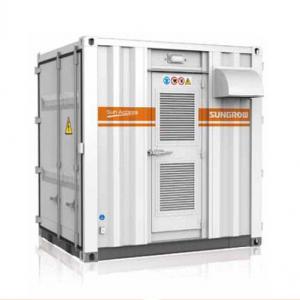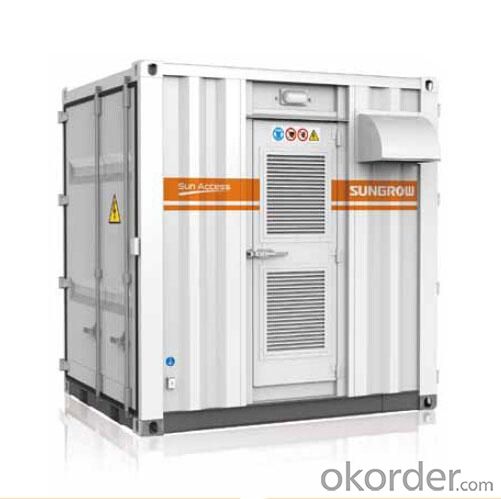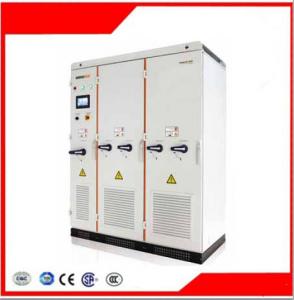Photovoltaic Grid-Connected Inverter SG1000TS
- Loading Port:
- China Main Port
- Payment Terms:
- TT or LC
- Min Order Qty:
- 50 unit
- Supply Capability:
- 1000 unit/month
OKorder Service Pledge
OKorder Financial Service
You Might Also Like
1. Structure of Photovoltaic Grid-Connected Inverter SG1000TS Description
A solar inverter, or PV inverter, or Solar converter, converts the variable direct current (DC) output of a photovoltaic (PV) solar panel into
autility frequency alternating current (AC) that can be fed into a commercial electrical grid or used by a local, off-grid electrical network.
It is acritical BOS–component in a photovoltaic system, allowing the use of ordinary AC-powered equipment. Solar inverters have
special functions adapted for use with photovoltaic arrays, including maximum power point tracking and anti-islanding protection.
Suitable for 50Hz grid, could be used in Asia, Australia and Europe.
2. Main Features of the Photovoltaic Grid-Connected Inverter SG1000TS
• 5 square meters area for megawatt-class equipment
• Transport and installation by forklift, more flexible and economical
• Open door design of three sides, easy for installation and maintenance
• More flexible for inner devices overall replacement
• Efficient cooling patented design
• Patented structure design of inlet and outlet, effective dust proof
• efficient heat insulation layer
3. Photovoltaic Grid-Connected Inverter SG1000TS Images
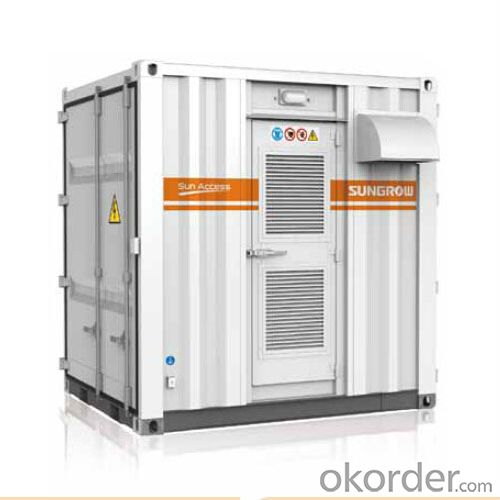
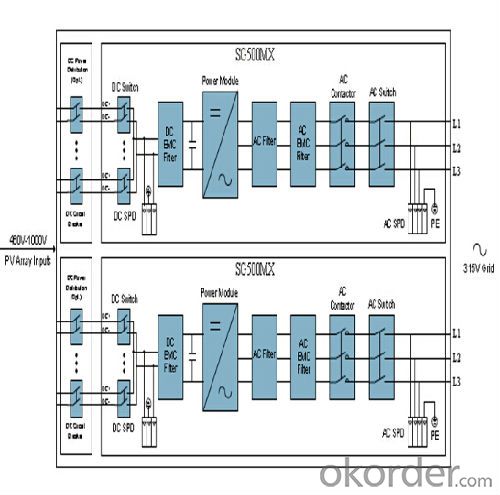
4. Photovoltaic Grid-Connected Inverter SG1000TS Specification
Input Side Data(DC) | |
Max. DC power (@ cos φ =1) | 1120kW |
Max. input voltage | 1000V |
Start voltage | 500V |
Min. working voltage | 460V |
Max. input current | 2440A |
MPPT voltage range | 460~850V |
Output Side Data(AC) | |
Rated power | 1000kW |
Max. output AC power | 1100kVA |
Max. output current | 2016A |
Max. THD | <3%(at nominal power) |
Rated grid voltage | 315V |
Grid voltage range | 252~362V |
Rated grid frequency | 50Hz/60Hz |
Grid frequency range | 47~52Hz/57~62Hz |
Power factor at rated power | >0.99 |
DC current injection | <0.5% of rated inverter output current |
Adjustable displacement factor | 0.9 (lagging) ~0.9 (leading) |
Efficiency | |
Max. efficiency | 98.70% |
European efficiency | 98.50% |
Protection | |
DC overvoltage protection | Yes |
AC overvoltage protection | Yes |
Grid monitoring | Yes |
Ground fault monitoring | Yes |
Overheat protection | Yes |
Insulation monitoring | Yes |
General Data | |
Dimensions(W×H×D) | 2538X2470X2050mm |
Weight | 4200Kg |
Operating temperature range | -35~50℃ |
External auxiliary supply voltage (Opt.) | 380V |
Cooling concept | Temperature controlled air-cooling |
Degree of protection | IP54 |
Max. permissible value for relative humidity (non-condensing) | 0~95%, non -condensing |
Max. altitude | 6000m ( >3000m derating) |
Communication port/protocols | Standard:RS485/ Modbus、Internet |
Options: CDT、DNP3.0、101、103、104、GPRS/CDMA module | |
5. FAQ of Photovoltaic Grid-Connected Inverter SG1000TS
Q1. What is the difference between inverter and solar inverter?
A1. Inverter only has AC inpput, but solar inverter both connect to AC input and solar panel, it saves more power.
Q2. What is the difference between MPPT&PWM?
A2. MPPT has higher efficiency, it can track the max power point and won't waste energy.
- Q: What is the role of a solar inverter in a utility-scale system?
- The role of a solar inverter in a utility-scale system is to convert the direct current (DC) electricity produced by the solar panels into alternating current (AC) electricity that can be fed into the utility grid. It also ensures the maximum power output of the solar panels by tracking the maximum power point. Additionally, the inverter provides grid synchronization and protection functions to ensure the safe and efficient operation of the utility-scale solar system.
- Q: How do you choose the right size of solar inverter for a solar power system?
- To choose the right size of solar inverter for a solar power system, you need to consider two main factors: the total power output of your solar panels and the maximum power consumption of your household or facility. First, calculate the total wattage of your solar panels by summing up the individual panel ratings. Then, assess your power consumption by considering the peak load requirements or the average daily consumption. Match the inverter's capacity to the higher value among these two factors to ensure efficient energy conversion. It is also recommended to consult with a professional solar installer to ensure the correct sizing of the inverter based on your specific needs.
- Q: What is the role of a bypass switch in a solar inverter?
- The role of a bypass switch in a solar inverter is to provide a means for redirecting the flow of electricity in case of an emergency or failure within the inverter. It allows for the direct connection of the solar panels to the utility grid, bypassing the inverter, ensuring a continuous supply of electricity even when the inverter is not functioning properly. This helps maintain the stability and reliability of the solar power system.
- Q: Can a solar inverter be used with a solar-powered remote monitoring system?
- Yes, a solar inverter can be used with a solar-powered remote monitoring system. The solar inverter converts the DC (direct current) electricity generated by the solar panels into AC (alternating current) electricity that can be used to power the remote monitoring system. This allows the system to be powered by solar energy and provides the necessary electricity for monitoring and data transmission.
- Q: Can a solar inverter be used in a solar-powered telecommunications system?
- Yes, a solar inverter can be used in a solar-powered telecommunications system. A solar inverter is an essential component in such systems as it converts the DC (direct current) electricity generated by the solar panels into AC (alternating current) electricity, making it compatible with the telecommunication devices and equipment.
- Q: What is the role of a solar inverter in a residential system?
- The role of a solar inverter in a residential system is to convert the direct current (DC) electricity produced by the solar panels into alternating current (AC) electricity that can be used to power household appliances and be fed into the electrical grid. It ensures efficient use of solar energy and enables easy integration of solar power into the existing electrical infrastructure of a home.
- Q: Does a solar inverter require a separate grounding system?
- Typically, a solar inverter requires its own grounding system. This is because the solar panels produce DC electricity, which needs to be converted to AC electricity by the inverter. The AC electricity is then either sent to the electrical grid or used within the building. Grounding is crucial for safety and proper functioning. In a solar power system, the grounding system provides a safe path for electrical current in case of faults like short circuits or lightning strikes. To prevent electrical shock hazards and comply with safety standards, a separate grounding system for the solar inverter is necessary. It safeguards the equipment, the building, and the people using or working on the system. The specific grounding requirements for a solar inverter may vary depending on local electrical codes and regulations. It is important to seek guidance from a qualified electrician or solar installer to ensure that the grounding system is designed and installed correctly for optimal safety and performance.
- Q: How does a solar inverter handle voltage dips or surges in the grid?
- A solar inverter handles voltage dips or surges in the grid by constantly monitoring the grid voltage. In case of a dip or surge, it quickly adjusts its own output voltage to match the grid voltage, thereby stabilizing the grid. This is achieved through various control mechanisms, such as voltage feedback loops and power electronics, which ensure that the solar inverter remains synchronized with the grid and provides a consistent and reliable power supply.
- Q: What is the role of a solar inverter in a solar panel system?
- The role of a solar inverter in a solar panel system is to convert the direct current (DC) electricity generated by the solar panels into alternating current (AC) electricity that can be used to power household appliances and be fed back into the electrical grid. It also ensures that the electricity produced by the solar panels is of the correct voltage and frequency for safe and efficient use in homes and businesses.
- Q: Can a solar inverter be used with a solar-powered electric fence system?
- Yes, a solar inverter can be used with a solar-powered electric fence system. The solar inverter is responsible for converting the direct current (DC) generated by the solar panels into alternating current (AC) to power the electric fence system. This allows the solar panels to efficiently charge the battery and power the electric fence, providing a renewable and sustainable energy solution.
Send your message to us
Photovoltaic Grid-Connected Inverter SG1000TS
- Loading Port:
- China Main Port
- Payment Terms:
- TT or LC
- Min Order Qty:
- 50 unit
- Supply Capability:
- 1000 unit/month
OKorder Service Pledge
OKorder Financial Service
Similar products
Hot products
Hot Searches
Related keywords
